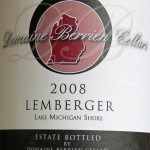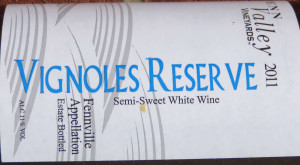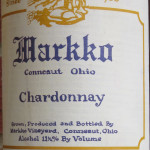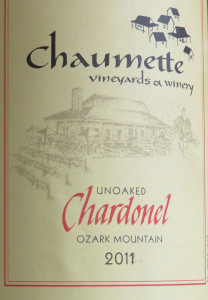How Well Does Midwest Wine Age?
Most of the wine purchased in the Midwest is consumed immediately or soon after purchase. In my experience, the best wines from our region are made to be enjoyed as soon as possible.
For both reds and whites, Midwest wines are usually not made from grape varieties that benefit greatly from aging. However, I recently opened some older bottles of Midwest wines and was pleasantly surprised.
Before sharing my tasting experiences, a suggestion to Midwestern winemakers: Invest in corks that can stand the test of time. Several of the wines I looked forward to drinking had decomposed corks. All the guilty bottles were stored on their sides, away from sunlight at nothing warmer than room temperature. There’s no excuse today for failed closures.
 2008 Domaine Berrien Lemberger– Aging Lemberger- aka Blaufrankisch- for five years is living on the edge. Medium bodied wines like this Michigan made variety don’t usually do anything but decline after half a decade in the bottle.
2008 Domaine Berrien Lemberger– Aging Lemberger- aka Blaufrankisch- for five years is living on the edge. Medium bodied wines like this Michigan made variety don’t usually do anything but decline after half a decade in the bottle.
But Domaine Berrien’s Lake Michigan Shore Lemberger still retained its red fruit qualities after a long sequester. The acidity was also toned down a least one notch compared with an unaged bottle.
This wine does not have much tannin to begin with. Credit the oak aging for giving this Lemberger enough of a backbone to morph into a mature wine with chocolate and coffee flavors that were not not there back in ’10 when I first tasted it.
 Fenn Valley Vignoles Reserve 2011– This wine is as forward as Joan Rivers in terms of fruit. Fenn Valley’s meticulous canopy management really shines here; the happy grapes must have been picked at the optimal moment. Mouthfeel is perfect. Residual sugar is not provided on the label, but I’d guess 2-3 percent. Slight oxidation added to the lush feel of the wine. My notes from 2012 say this wine was a little overpowering, but now it’s well balanced and fantastic. As I recall, 2011 got off to cold start in Michigan, but the fall was warm. There’s also a hint of autumn in this wine and Vignoles is a difficult grape to let hang.
Fenn Valley Vignoles Reserve 2011– This wine is as forward as Joan Rivers in terms of fruit. Fenn Valley’s meticulous canopy management really shines here; the happy grapes must have been picked at the optimal moment. Mouthfeel is perfect. Residual sugar is not provided on the label, but I’d guess 2-3 percent. Slight oxidation added to the lush feel of the wine. My notes from 2012 say this wine was a little overpowering, but now it’s well balanced and fantastic. As I recall, 2011 got off to cold start in Michigan, but the fall was warm. There’s also a hint of autumn in this wine and Vignoles is a difficult grape to let hang.
 2007 Marrko Chardonnay- Bursting with flavors of lemon meringue, this naturally fermented wine also carried the weight of subtle, melded oak. The qualities of a marshmallow that has been perfectly browned over a campfire could be ascribed here. The acidity of Midwestern Chardonnay can be on the high side, but time has softened this wine considerably. The alcohol listed on the bottle is 11.5% indicating that Ohio Lake Erie shore grapes did not get super ripe in ’07. The aged wine has medium mouthfeel, a long lemony finish with some spices and pepper. For a seven-year-old wine that has not been filtered, there was remarkably little sediment at the bottom of the bottle. Considering the wine was made with spontaneous fermentation, such stability over such a long time is remarkable.
2007 Marrko Chardonnay- Bursting with flavors of lemon meringue, this naturally fermented wine also carried the weight of subtle, melded oak. The qualities of a marshmallow that has been perfectly browned over a campfire could be ascribed here. The acidity of Midwestern Chardonnay can be on the high side, but time has softened this wine considerably. The alcohol listed on the bottle is 11.5% indicating that Ohio Lake Erie shore grapes did not get super ripe in ’07. The aged wine has medium mouthfeel, a long lemony finish with some spices and pepper. For a seven-year-old wine that has not been filtered, there was remarkably little sediment at the bottom of the bottle. Considering the wine was made with spontaneous fermentation, such stability over such a long time is remarkable.
 Braganini Michigan Reserve 2009 Chancellor Noir- The bottle was upright in a moderately heavy backpack when I set it down on the concrete beside my car. As the protected bottle softly met the concrete floor, there was a small sound like a lightbulb breaking inside a box of packing foam. I did not want to believe that bottle was broken, but the wine trickling slowly out of the backpack indicated tragedy.
Braganini Michigan Reserve 2009 Chancellor Noir- The bottle was upright in a moderately heavy backpack when I set it down on the concrete beside my car. As the protected bottle softly met the concrete floor, there was a small sound like a lightbulb breaking inside a box of packing foam. I did not want to believe that bottle was broken, but the wine trickling slowly out of the backpack indicated tragedy.
So this review is based on less then ideal circumstances. A faint volatile acidity aroma wafted from the concrete surface, but there were also wonderful dark chocolate and leather aromas as the wine ran down the floor of the parking garage.
This is not the first time a wine bottle has broken after a seemingly minor impact. Once in Southern Illinois, I lost a bottle of Traminette when the bottle shattered after simply falling on its side.
 Chaumette Vineyards and Winery, 2011 Unoaked Ozark Mountain Chardonel- Hank Johnson likes to taste his unoaked Missouri Chardonel side by side with California Chardonnay when his West Coast friends come to visit his gorgeous Missouri winery. He says they often can’t tell the difference in blind tastings. In my experience, Chardonel has far more acidity than Chardonnay and the difference is apparent. And like many hybrid grapes, Chardonel can have a little green onion on the finish. After several years of aging, the modest astringency of Chaumette Chardonnel had dimished but the wine was still crisp and bright. It would take an advanced palate to identify the aged Chaumette Chardonel as a hybrid wine. And what does it matter? Good wine is good wine.
Chaumette Vineyards and Winery, 2011 Unoaked Ozark Mountain Chardonel- Hank Johnson likes to taste his unoaked Missouri Chardonel side by side with California Chardonnay when his West Coast friends come to visit his gorgeous Missouri winery. He says they often can’t tell the difference in blind tastings. In my experience, Chardonel has far more acidity than Chardonnay and the difference is apparent. And like many hybrid grapes, Chardonel can have a little green onion on the finish. After several years of aging, the modest astringency of Chaumette Chardonnel had dimished but the wine was still crisp and bright. It would take an advanced palate to identify the aged Chaumette Chardonel as a hybrid wine. And what does it matter? Good wine is good wine.


I remember an article written by the late St. Louis post-dispatch food writer Joe Pollak about Norton wines can go up to 15 years.